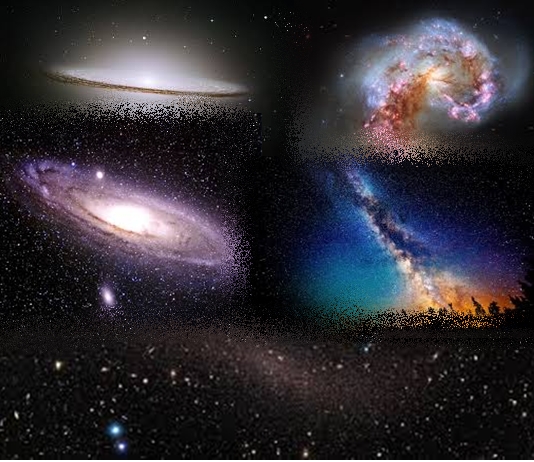It is said that making mistakes is human but blaming others for the mistake is even more human. The question is, who it is when, after making many mistakes and owning them, if one still remains proud? The closest answer I find is, a modern atheistic scientist. I mean nothing mean. My answer comes from experience. Making mistakes, imposing them on others as facts, realizing they were wrong, admitting it, and again imposing new findings as facts has been their regular pattern. Interestingly, that’s how they define science. Recently, the previously thought age of Earth turned out to be wrong. Now the previously thought number of galaxies turns out to be wrong. Earlier they said the total number of galaxies in the universe were around 120 billion. Now they say it must be 2 trillion!
Despite their embarrassing past assumptions concerning the universe, about the Earth, about the Moon, about the Sun, about practically anything, and despite their repeated admittance that their previously thought theories were wrong, almost every time when they come up with a new theory they claim it to be perfect. Not only that, they change text books based on the new theory only to change them a few decades later.
Am I sarcastic, or realistic? Read on and decide yourself.

First, let us see how they calculate the number of galaxies in the universe.
“Since the mid-1990s, the working estimate for the number of galaxies in the Universe has been around 120 billion. That number was based largely on a 1996 study called Hubble Deep Field. Researchers pointed the Hubble Space Telescope at a small region of space for a total of ten days so that the long exposures would reveal extremely faint objects. This view encompassed galaxies up to 12 billion light years away, which we see as they existed less than two billion years after the Big Bang. Astrophysicists then counted the galaxies within that narrow field of view and extrapolated the number to the full sky—under the assumption that it would look similar in all directions—to get to the 120 billion figure.”
So the 120 billion figure came after they kept their best considered telescope for 10 days focusing on a small region of space. Imagine how many things they assumed.
They assumed that the density of galaxies in the universe is homogeneously spread across the universe. They assumed that the light spread across the universe is also homogeneous. They assumed that the movement of time is also the same throughout the universe.
They assumed all this is when they calculate the diameter of the observable universe about 91 billion light-years (28×109 pc), the age of the universe at some 13.82 billion years, and when they have no clue, whatsoever, as to how the time functions.
No surprise the figure of 120 billion total galaxies turns out to be wrong.
“”However, there weren’t enough galaxies in the Hubble Deep Field image to account for the density of matter distributed throughout the Universe. The missing matter had to be in the form of galaxies too faint to see, as gas and dark matter. “We always knew there were going to be more galaxies than that,” says astrophysicist Christopher Conselice of the University of Nottingham, UK. “But we didn’t know how many existed because we couldn’t image them.””
One thing I appreciate is, nowadays scientists have realized that as the technology advances, they will find more mysteries in the universe and probably also the answers to them. Keeping this in mind, many of them have begun to state that future findings may give a different estimate. This is a wise step considering neither our machines nor our senses are perfect. Vedic scripture warns us against depending on our senses while seeking the truth.
As NASA upgraded the observatory, more galaxies surfaced.
“More recent deep-field studies conducted using Hubble—after NASA astronauts upgraded the observatory in 2009—and other telescopes enabled Conselice and collaborators to count visible galaxies out to distances of 13 billion light years. They were able to plot the number of galaxies of a given mass that corresponded to various distances away from Earth. The researchers then extrapolated their estimates to encompass galaxies too small and faint for telescopes to pick up. Based on this, they calculated that the observable Universe should contain 2 trillion galaxies. The paper1 will be published in the Astrophysical Journal.” (Excerpts from Universe Has 10 Times More Galaxies Than Researchers Thought)
So previously they thought and declared there were total 120 billion galaxies; now they got 2 trillion. That’s almost 20 times more. But the same research pattern will go on and history will repeat. Considering the current astronomical technology allows just 10 per cent of galaxies, the remaining 90 per cent still remains a mystery. “We are missing the vast majority of galaxies because they are very faint and far away. The number of galaxies in the universe is a fundamental number we would like to know, and it boggles the mind that over 90 per cent of the galaxies in the universe have yet to be studied,” Mr Conselice was quoted as saying.
One may question why I call this new finding a setback instead of a success, a step forward.
It is said that attitude is everything. The same goes when it comes to accepting big time mistakes done by modern atheistic scientists. They are leaving no stone unturned to prove that they are in control, not God. They refuse the existence of any divine intelligence but they cannot say how, without such intelligence, the gigantic galaxies in the universe, number of which they cannot ascertain, are created, maintained and destroyed, all in a most scientific way.
The modern atheistic science attempts to make people believe that today’s scientists are the most intelligent ones in the history because they can operate space crafts and space stations from great distance, sitting on Earth, but they have difficulty accepting that if a tiny space station needs a big team of scientists, the innumerable number of planets and galaxies floating in the space for trillions and zillions of earthly years must have terrific intelligence behind it. And if the intelligence is there, there must be the intelligent who operates it, just like energy is operated by the energetic. This supremely intelligent being is the Personality of Godhead, but the atheistic class of people, including a good number mainstream scientists today, want to defy the existence of that Supreme Person, or God. This is why they are perpetually bewildered by God’s energy.
On the other hand, as mentioned in this article, the science described in the Vedas is infallible. Modern science is extremely confused and is bound to get even more confused. Although gradually it is coming closer to understanding what is mentioned in the Vedas and Upanishads, it is still in its infancy. It is not possible to understand all of the universe by ordinary human beings due to their limited senses and meager brain power. Not to speak of understanding, present-day scientists cannot even see how the universe is operated by higher beings, called devatas or demigods. The only way to get an idea of it is, first accept what is mentioned in the Vedas. By following Vedic process one can transcend his or her present material senses and come to know the higher science.
If the purpose of science is to know the truth, why not take help from the infallible, descending knowledge stored in the Vedas? Vedic wisdom is not meant only for India. It is there for the whole world, including the scientists, to benefit from. Accepting the authority of the Vedic science does not minimize the value of modern science and its many wonderful achievements. In fact, it will help today’s scientists get a glimpse of an untold number of planets and galaxies which are beyond the imagination of any earthly being.































